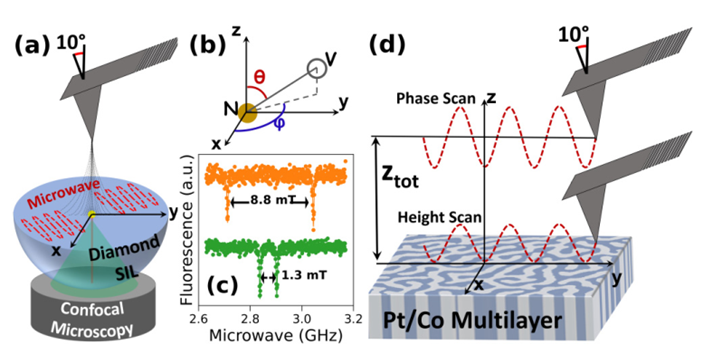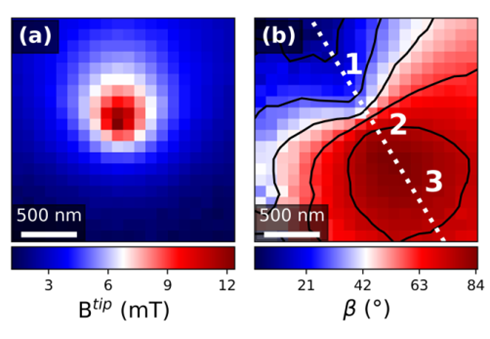Study of Quantum Calibrated MFM with NV Center in Diamond by Yan Liu Published on PRB
2022/02/10
Dr. Yan Liu, BAQIS Assistant Researcher from Atomic Ensemble Precision Measurement Group, and his collaborators from Germany proposed and realized calibration of magnetic force microscopy with a single NV center. The results have been published on Physical Review B recently. Dr. Liu is the corresponding author and one of the first authors of the paper.
The nitrogen vacancy (NV) color center in diamond is formed by a substitutional nitrogen atom and an adjacent vacancy in diamond lattice. It is optically active with good stability. In favor of the robust diamond structure and spin purity, NV center has coherence of ~ms in ambient condition which makes it a unique solid-state quantum platform. With quantum coherence measurement techniques, NV can be used for probing magnetic field, electric field, temperature, pressure and so on with extremely high spatial accuracy.
Magnetic force microscopy (MFM) is an extension of atomic force microscopy (AFM). MFM is an efficient magnetic field detection instrument with high speed and high spatial accuracy, which is widely used in characterization of magnetic materials, readout of information stored in magnetic media, characterization of superconducting materials, etc. The probe of MFM is similar to that of AFM. An MFM probe is usually fabricated by coating ferromagnetic materials over an AFM tip. In most cases, calibration of an MFM tip is processed by scanning it over a reference sample and hereafter data analysis with the attractive and repulsive forces. Calibrations like this, however, show systematic limitations: one is that as the reference sample has field uncertainty limiting the uncertainty of the calibration; second the interaction between the magnetic reference sample and the magnetic MFM tip may perturb the calibration. This may eventually lead to transformation of the MFM tip properties during the calibration.

Figure 1. (a) Experimental setup built for this work. With MFM tip scanning over the top side of the diamond sample, the NV spin is manipulated and measured through the bottom side with the confocal microscope for calculating magnetic field from the tip. (b) NV can be used as vector magnetometer, regarding to its orientation and the field axis. (c) Electron spin resonance spectra with the NV center. (d) The scheme for classical MFM tip calibration.
To address the above issues, Dr. Yan Liu collaborated with Prof. Fedor Jelezko team from Ulm University in Germany and Prof. Hans W. Schumacher team from PTB in Germany, proposed and realized the quantum calibration of MFM with a single NV center. Following basic quantum principles, NV center functions as a self-calibrated sensor. And its host, diamond, which is a semiconductor, does not induce any perturbation with the MFM tip.
This study achieved 400 measurements of magnetic fields with very high gradient in a grid of 2×2 μm2 plane area with 80 nm away from the MFM tip. Since NV is a vector magnetic field sensor, further analysis gives the angles between the NV axis and the field axes. With these data, imaging of both MFM tip field and its angles were achieved with spatial resolution of 10 nm. The result is compared to the result of classical MFM calibration in the paper. Dr Yan Liu is the corresponding author and one of the first authors of the paper.

Figure 2. (a) Imaging of the MFM tip field through quantum measurement of the single NV center. (b) Imaging of the angles between the single NV axis and the tip field axes from the same measurements.
"MFM tips are provided by many companies. With scanning electron microscopy, All these companies confidently provides dimensions of the MFM tips in the few~nm scale, the thickness of the coated magnetic materials, etc. However, magnetic field values of a MFM tip usually are not mentioned by most suppliers. Part of the reason is that variations of classical calibration reference samples and data analysis processes could lead to inconsistent calibration results. The quantum calibration protocol introduced by us is a convincing solution for both MFM tip producers and the end users to determine the magnetic properties of the MFM tips.", says Dr. Yan Liu.
During the study, Dr. Yan Liu was sponsored by the Sino-German (CSC-DAAD) postdoc Scholarship project and Volkswagen Stiftung, etc. The study was funded by German Science Foundation (DFG), European Research Council, Federal Ministry of Education and Research (BMBF) in Germany. This research was also supported with diamond sample by Element Six (UK) Ltd. and atomic microscope by JPK Instrument AG.
Reference: Baha Sakar, Yan Liu, Sibylle Sievers, Volker Neu, Johannes Lang, Christian Osterkamp, Matthew L. Markham, Osman ?ztürk, Fedor Jelezko, and Hans W. Schumacher Phys. Rev. B 104, 214427
 中文
中文 Email
Email QCloud
QCloud Log in
Log in
